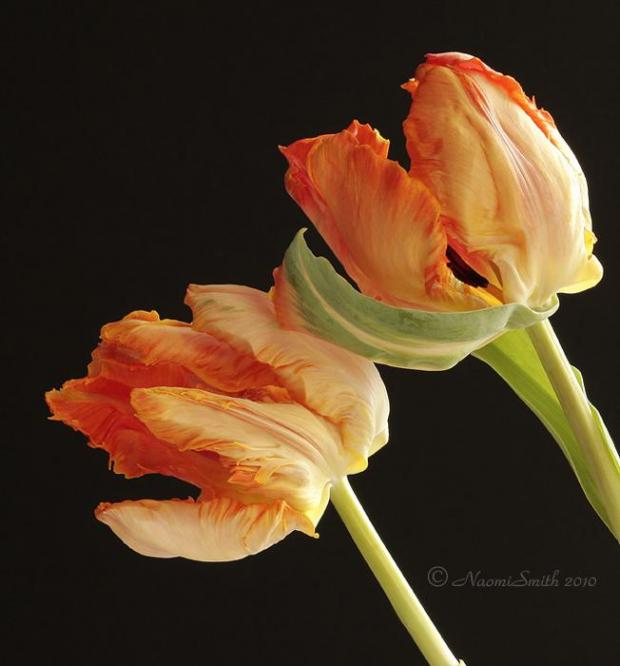
Visitors to VanDusen Botanical Garden and the public gardens of the West Coast may think of the glorious month of April as tulip season. For the professional gardener, though, there is another tulip season — the fall season of hard labour and planting that must precede spring. “Glorious” would never come about without “labourious.”
On a good day, a gardener can plant 4,000 bulbs, provided that someone else has prepared the beds and laid out the bulbs. Having spent years of days-on-end planting tulips (literally “on end” in a hunched over, head-below-the-waist position), I’ve had occasion to rue my Dutch ancestors’ fascination with the tulip.
It’s a quirk of botanical irony that a plant whose natural habitat was once mountainous terrain — the snow-covered, high elevations of Central Asia — has become the national symbol of a country one-third of which lies below sea level. In the fascinating story of the tulip, credit (or blame!) goes to a botanist and to a botanical garden that changed horticultural history.
Carolus Clusius was the Flemish Prefect of the Imperial Gardens in Vienna, where tulips were sent from Turkey by a Hapsburg ambassador. In 1593, he took up a professorship in Holland at the University of Leiden, and the tulips came with him. As with all the famous gardeners and botanists of the day, Clusius was a medical doctor. Botanical gardens were institutions entirely devoted to medicinal plants, but the European world of botany was undergoing momentous change as numerous new and exotic plants arrived from the Americas, Africa and the Middle East. Gardener-botanists thought they knew what local or European plants could cure. They could only take wild or “educated” guesses at the utility of these new plants.
Perhaps it was the tulip that ultimately changed our botanical garden paradigm. Clusius established Hortus Academicus in Leiden. It was the first botanical garden that was devoted to ornamental plants, as well as its usual preoccupation with medicinal ones. Despite misgivings among the public concerning the manipulation and creation of “nature’s bastards” (read Perdita’s condemnation of them in Shakespeare’s The Winter’s Tale), Clusius’s tulip breeding produced cultivars of remarkable variation and beauty within a relatively short time. Within 40 years, the public’s ever-expanding interest in tulips, and floral beauty for its own sake, culminated in the speculative madness of “Tulipmania.”
At this point, we leave behind the rooted world of horticulture and enter the psycho-surreal world of finance. People were buying and selling tulips for large fortunes, not to plant them, but in anticipation of ever-increasing value. Sounds like the stock market, doesn’t it? Indeed, the French term for stock exchange, "bourse", is thought to come from the name of the family in whose home much of the tulip trading took place — Van Bourse. It all came to an abrupt crash in 1637. Fortunes were lost, and the tulip regained its humble place as merely a beautiful flower.
Tulips are once again big business in the Netherlands, somewhat more legitimately so today than in 1637. More than 3,500 tulip hybrids and species are commercially propagated there. The Netherlands produces more than 3 billion tulips annually, making tulips the world’s most important ornamental flower cash crop. The Dutch have a good deal to thank Clusius and botanical gardens for.
Back when Tulipmania imploded, many would have remarked that God was punishing those who supported the creation and sale of “nature’s bastards.” Did Clusius go against God and nature by shifting the focus of his botanical garden, from “science” and medicinal usefulness, to ornamental beauty? He may very well have not seen it that way. In the “science” of the times, the degree to which God made a plant beautiful would have been viewed as an indication of its medicinal power. Did Clusius, when he was “improving” the beauty of the tulip, believe he was increasing its medicinal potency? Quite possibly. There’s some interesting botanical sleuthing to be done in this area.
As with many “new” plants that Europeans first encountered during the Renaissance, tulips never had a medicinal use attached to them. The gardener-botanist-doctors of the day never got around to figuring out what a tulip might cure. I only know what tulips cause every fall — a sore back!
Author: Harry Jongerden, Garden Director, VanDusen Botanical Garden
(Adapted from an article by the author previously published by Royal Botanical Gardens, Hamilton.)




